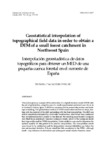Geostatistical interpolation of topographical field data in order to obtain a DEM of a small forest catchment in Northwest Spain

Ver/
Use este enlace para citar
http://hdl.handle.net/2183/6522Coleccións
Metadatos
Mostrar o rexistro completo do ítemTítulo
Geostatistical interpolation of topographical field data in order to obtain a DEM of a small forest catchment in Northwest SpainTítulo(s) alternativo(s)
Interpolación geoestadística de datos topográficos para obtener un MED de una pequeña cuenca forestal en el noroeste de EspañaData
2001Cita bibliográfica
Cadernos do Laboratorio Xeolóxico de Laxe, 2001, 26: 179-190 ISSN: 00213-4497
Resumo
[Abstract] This article gives an example of the elaboration of a digital elevation model (DEM) with the aid of geostatistics, using the case of a small experimental catchment near Arcos de la Condesa in Galicia, Spain. A DEM is a necessary tool in present-day erosion and landscape modelling. The geostatistical method of DEM construction involves six steps, starting with the removal of the drift and ending with the final interpolation. The drift was almost completely eliminated by a first order trend surface. After it had been confirmed that no heteroscedacity is present in the data set, the resulting experimental variogram was fitted by an anisotropic Gaussian variogram model, which is the variogram model that is generally used for DEM interpolation. Cross validation was used to determine the optimal number of data points to be used in interpolation. The interpolation results were found to be satisfactory and the interpolation standard deviations are below the data set standard deviation. It is yet noted that this uncertainty in the DEM – although small – may influence its derivatives and subsequent model results. However, when compared to other methods of DEM elaboration, the method as used here is an easy, adequate and relatively fast method, that has the major advantage of providing interpolation errors, enabling an evaluation of the interpolation result.
Palabras chave
Geostatistics
Kriging
Interpolation
Anisotropy
DEM
GIS
Kriging
Interpolation
Anisotropy
DEM
GIS
ISSN
0213-4497





